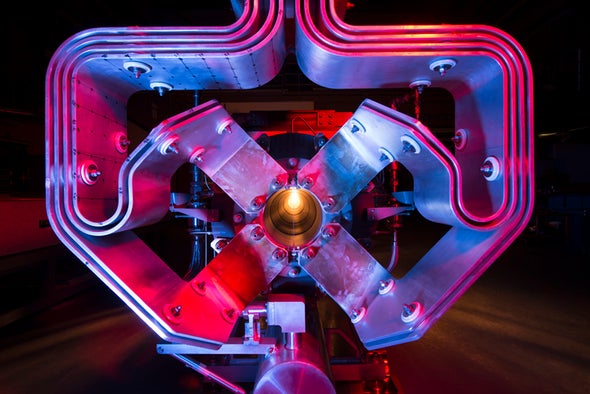A first-of-its-kind probe brings physicists one step closer to solving the proton radius puzzle

For a lesson on just how much—and just how little—we really know about the universe, consider protons. We know these tiny, positively charged particles reside within the nucleus of every atom and constitute most of the ordinary matter in the universe. We know a proton paired with an electron makes hydrogen—the first element on the periodic table and the fuel that allows stars to shine. We know protons themselves are composed of a trio of even smaller particles called quarks—which we learned in part by building gigantic, multibillion-dollar machines to slam protons together at nearly the speed of light. Protons are the workhorses of cosmic creation and particle physics alike—yet, despite all this, we struggle to know simply how big they are.
After a half century of effort, by the turn of the millennium physicists thought they were approaching an answer. Using two types of ultraprecise measurement that each probed the proton’s electric charge, researchers pegged the particle’s radius as about 0.877 femtometer (a femtometer is a trillionth of a millimeter). But in 2010 a new, even more precise electric charge technique suggested the proton’s radius was some 4 percent smaller still—a seemingly minuscule discrepancy that nonetheless deviated immensely from theoretical expectations.
Most physicists considered this “proton radius puzzle” solved in 2019 when painstaking follow-up work convincingly settled on the lower value for the particle’s size as correct. (Whether the discrepancy was because of experimental errors or the signposting of as-yet-unknown physics remains up for debate.) Now researchers using a new and entirely independent method to measure proton size—one involving neutrinos rather than electrical charge—are weighing in, too. Their findings were published in Nature in February.
This switch matters because a proton, like all things in the quantum realm, is less a concrete object with well-defined boundaries and more a hazy cloud of probabilities. There is no physical membrane that delineates where a proton starts and where it ends. There is instead a shape-shifting maelstrom of quarks, and physicists can map quark distribution to estimate the proton’s size. But quarks have their own slippery, probabilistic properties, too—any answers they reveal depend on what exactly they are being asked, and querying them via electrical charge is a different sort of question than probing with neutrinos, which have no charge. Getting answers to both, then—the proton’s “electric charge radius” as well as its “neutrino radius”—is a potent cross-check of the proton’s size.
The puzzle-solving electric charge radius results of 2019 largely emerged from work at the Thomas Jefferson National Accelerator Facility (Jefferson Lab) in Newport News, Va., where physicists shot beams of electrons at proton-packed hydrogen. By tracking how the electrons in each beam ricocheted off the hydrogen molecules’ protons, the physicists could progressively sketch out the electric charge distribution for a single proton—in other words, its size. With electrically neutral neutrinos, this sketch changes quite a bit. Neutrinos are so elusive that trillions of them pass through your hand every second without interacting with you. This means any interaction that does occur takes place very, very close by, making neutrinos useful in measuring other small things.
“I always imagine this as different ways of looking at stuff … we have a lot of difficulties seeing our universe in terms of these neutrinos because they’re so difficult to measure,” says Tejin Cai, a postdoctoral researcher at York University in Toronto. Cai led the Main Injector Neutrino Experiment to Study v-A Interactions (MINERvA) collaboration at the Fermi National Accelerator Laboratory (Fermilab) in Batavia, Ill., in the latest hunt for the proton structure using an antineutrino beam—which many of his colleagues thought would be futile. (An antineutrino is the antimatter counterpart of a neutrino. MINERvA uses both, but measuring the outcome of an interaction with protons is easier with antineutrinos.)
The proton’s three quarks are separated into two types, or flavors: two “up” quarks and one “down” quark. As Fermilab’s tiny, mighty antineutrinos smashed into a proton, they turned one of its up quarks into a down quark, converting the proton into a neutron (which has the opposite quark configuration of a proton). Based on the location of this new neutron, the physicists then worked backward to figure out where the shape-shifting up quark was at its moment of transformation, and this provided clues about its distribution within the proton.
“What excites me about this measurement is that we were able to use neutrinos to do something we were only able to do with electrons previously,” Cai says.
The team’s measurement of the proton’s radius was 0.73 femtometer, even smaller than the 0.84-femtometer electric charge radius. In either case, it is almost 10,000 times smaller than a hydrogen atom.
To be clear, this apparent 13 percent shrinkage is not a blow to the electric charge radius measurements and not as shocking as it may seem. The two measurements are complementary and work together to offer a big picture view of the little proton. Because they measure different distributions of matter, the discrepancy does not challenge our understanding of the proton the same way its previous 4 percent shrinkage did. Instead it adds to that understanding.
“The thing that makes this measurement really interesting is not whether or not it agrees with the electron measurements of the electromagnetic proton radius but the fact that it didn’t have to agree at all,” says Deborah Harris, co-spokesperson for the MINERvA experiment. This is because the way neutrinos interact with up quarks versus down quarks is very different from how quarks interact with electrons. Instead of an electromagnetic interaction, neutrinos interact via a different force called the weak force. (But don’t let its name fool you—the weak force is quite strong across subatomic distances!)
In fact, the proton’s “weak charge” radius, so to speak, and its electric charge radius do agree with each other within their uncertainty ranges, and it’s not particularly surprising that the radii are similar. Electron scattering experiments measure where an electron touches a quark’s charge, and neutrino experiments measure where an antineutrino changes a quark’s flavor. These two regions should be near each other because they both depend on the location of a quark’s shape-shifting cloud. But perhaps even more impactful than an updated understanding of the proton’s structure is the new study’s implications for how neutrinos can be used in the future.
“This new measurement is equally important—maybe even more important—than ours because it’s addressing a new type of interaction,” says Ashot Gasparian, a physicist at North Carolina Agricultural and Technical State University, who was one of the authors of the electric charge radius study at Jefferson Lab. These interactions, he says, are important in understanding other big problems in physics besides the proton radius, such as the mystery of how neutrinos acquire their infinitesimal mass.
ABOUT THE AUTHOR(S)
Anashe Bandari is a science writer specializing in physics and astronomy. She has written for NASA, the American Institute of Physics, and more. Follow her on Twitter @astrAnashe
Note: This article have been indexed to our site. We do not claim legitimacy, ownership or copyright of any of the content above. To see the article at original source Click Here













